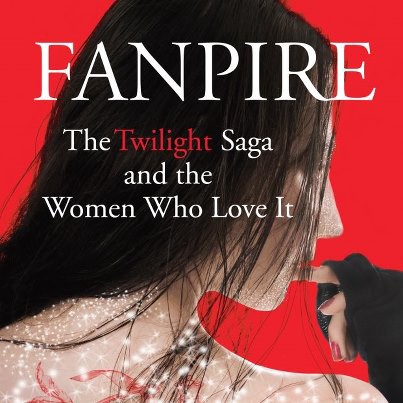From the Introduction: Welcome to the Twilight Zone
As I sit attentively in the lecture “So Many Species, So Little Time: The Men of Twilight,” a teenage girl wearily plunks herself down beside me. Rachel’s face is obscured by stringy blonde and purple-streaked hair, but I can see her wrists, clad in dozens of black rubber bracelets. One reads, “I’m in love with a fictional character.” She scribbles notes, and when she nonchalantly meets my gaze, I see that Rachel’s unnaturally golden-brown irises are encircled by orange and black, the result of vampire-inspired contact lenses. Our classroom door has a sign that reads, “No Vampires beyond Here!” and as the talk ends, a scratchy but authoritative voice explodes from the intercom system: “Will Bella Swan please report to the principal’s office!” Rachel eagerly confides with me whether she’d like a boyfriend to be a human, vampire, or werewolf. Vampire, or rather the revamped twenty-first-century version of the vampire, wins by a landslide. To Rachel and others like her, he’s old-fashioned but still sexy, loyal but tantalizingly dangerous, brooding and anguished about his bloodthirsty nature, young with an artfully disheveled head of hair.
I have officially entered the Twilight Zone, as the banner over the high school where we’re sitting proclaims. Rachel is indeed a student, but not here at Forks High School in Washington State, which is hosting a Summer School symposium on the Twilight saga. Rather, she’s a self-described “twi-hard,” just one of the millions of fervent fans, who range from ages ten to eighty. The beloved series is an ongoing young-adult romance between the exceptionally clumsy teenager Bella Swan and a swoon-inspiring vampire named Edward Cullen, who has been seventeen years old since 1918. Thousands of fans like Rachel have flocked to Forks, Washington, an economically depressed former logging town, eager to immerse themselves in the setting for the books. Forks has responded by remodeling itself as a destination for all things Twilight.
The Twilight “fanpire” spans the globe, but Rachel traveled from Bloomington, Indiana, to be here at the Twilight Summer School. Her obsession with the series began when a friend recommended it to her. Entranced, Rachel spent the night in the bathtub finishing the first book as the water cooled and her skin puckered. She proceeded to tear through the other books in the series, but those weren’t enough to satisfy her enthrallment. She logged onto fan sites like His Golden Eyes and Twilighters Anonymous for at least one hour each day to chat with other fans and peruse the latest Twilight gossip. When I spoke with Rachel at the Summer School symposium, she told me that the current buzz in the fanpire centered around a YouTube video of a recent screening of Eclipse where a man proposed to his girlfriend on bended knee in front of the theatre audience. The couple then rejoined the cheering crowd to watch the film.
Rachel’s wardrobe consists of Twilight-themed shirts reading, “Bite Me: Vampires Only Please” and “It’s an Edward Thing, You Wouldn’t Understand.” After months of pestering, she’d convinced her mom and her cousins, who’d finally succumbed to Twilight mania, to wait in line at Barnes and Nobles with hundreds of other girls for the midnight release of Breaking Dawn, the final book in the series. An enormous poster of Robert Pattinson, the actor who plays Edward, looms over her bed where he watches her sleep. No boy at her high school can pass muster next to the impossibly sparkly perfection of Edward.
Rachel describes the process of reading Twilight as being spellbound, a sensation akin to the bliss of encountering a favorite book for the first time. “I don’t know what it is about the Twilight series that has captivated me,” she tells me. “Once I had read Twilight, my life was changed.” Fans call this phenomenon Twitten, reading the first book and getting bit by the Twilight bug, the inexplicable force that drove them to read all the books in (practically) one sitting. At the elementary school down the block from my house in Washington, fifth graders segregate themselves in the schoolyard according to their allegiances to various male characters, “Team Jacob” or “Team Edward.” Friends are forsaken as a result of affiliating with one emblem of eros over another. Other fans dissect the personalities of the Cullens, Edward’s fabulously wealthy and attractive vampire family, and bicker over the merits of the Quileute werewolf pack. They write fan fiction, serial novels in countless genres, including the popular “fade to black” fiction with its explicit erotic and sexual details.

Many Twilight fans had never read an entire book before picking up the series, and now they are inhaling it in repeated readings of ten, fifteen, or fifty times. They build websites like Twilight Singapore, gay and lesbian fans create Facebook pages dedicated to the series, and through it discover lifelong friends. At conventions, they donate blood, exchange extra Twilight buttons and t-shirts, and bond over bonfires, lunches, and volleyball games. They book tickets for the Twilight cruise to Alaska to mingle with fans and celebrities from the films, read the Twilight graphic novel, meet up with a Twilight mom’s group, or buy Twilight merchandise like Sweetarts, a heart-shaped candy that says “bite me” or “soul mate.” They wear the au courant raincoat from Nordstrom’s Twilight-inspired fashion line. Fans like Rachel do not want to merely read the books; they want to climb inside them and live there.
This book is about the pleasures of the millions of devoted Twilight fans like Rachel who have transformed the Twilight saga into a cultural phenomenon. Thirteen million copies of the books have been sold in the United States; 116 million copies, worldwide, with translations into thirty-seven languages. The film adaptations are some of the highest-grossing movies of all time. Meanwhile, the Twilight saga has spent more time on the New York Times best-seller list than even the Harry Potter novels. Its appeal can be encapsulated in the fact that it was recommended to me by my daughter’s forty-year-old preschool teacher, a fourteen-year-old neighbor, and a university colleague as must-reads.
Fanpire, one of the collective terms Twilight fans use to describe themselves, evokes the ubiquity and popularity of the Twilight phenomenon, as well as the fact that its readers cross generations, economic strata, and countries. Fans from Romania to Salt Lake City have invented a Twilight-inspired universe that encompasses all aspects of their lives: from Edward-addiction groups and “twi-rock” music to Cullenism, a religion based on the values of Edward’s family of vegetarian vampires. There is a lexicon of fan terms: Twilighter: a Twilight fan; Twi-hard: a die-hard Twilight fan; and Twibrary: your collection of all things related to Twilight.
I met fans on tour buses to Twilight-inspired sites; attended thousand-strong conventions; danced at a vampire ball; watched the film premiere of New Moon with four thousand primarily Mormon Twilight moms in Utah; befriended people who adorn their bodies with tattoos like the one on the cover of this book; observed vampire baseball games; and struggled through a Bella self-defense class. Approximately 600 people responded to my online fan survey within a few days after some of the major fan websites provided links to it. Their responses, as well as the interviews I conducted with fans in person and online, and my own participation in the fanpire, form the basis of this book.
Is a fan someone who camps out for weeks in a grimy parking lot for a glimpse of a Twilight film star, or is it the person who feels ecstatically transported simply while reading the books? We are all fans of something, whether our fanaticism is private or public, shameful or prideful, steadfast or capricious. Scholars have extensively researched fans and fandoms. Fans are nomadic, and the way they relate to texts is never stable or final. Many travel between fandoms and tastes: young adult fantasy literature, vampire lovers, and romance readers.
The fanpire in the United States, based on my online survey, tends to be almost 98 percent women. Eighty percent identify as nondenominational Christians or Catholics while the remainder self-describe as “spiritual.” In my survey, 85 percent of respondents were white, and most respondents over age eighteen had completed at least two years of higher education. However, like any amorphous and heterogeneous phenomenon, the fanpire eludes easy classification.
Editors Note: The final film in the Twilight Saga — Breaking Dawn Part 2 opens on November 16
___________________________
Excerpted from Fanpire: The Twilight Saga and the Women Who Love It by Tanya Erzen, published in October 2012 by Beacon Press. Next up on the Fanpire Blog tour is Feminism and Religion.






